
STANLEY ROSEMAN
LANDSCAPES of FRANCE
Fields and Woodlands in Winter, 2006, (fig. 2, below), expresses the grandeur of nature in its winter slumber.
A Light Snowfall in the Ardennes, 2008
Oil on canvas, 29 x 60 cm
Private collection, France
Oil on canvas, 29 x 60 cm
Private collection, France
Roseman paints and draws landscapes throughout the four seasons. A Light Snowfall in the Ardennes, 2008, presented above, is a beautiful landscape painted in the countryside in the department of the Ardennes in northeastern France. The snowfall at the beginning of winter has whitened passages of a hillside. The artist's fluent, white brushstrokes are expressive of the gently rolling terrain.
© Stanley Roseman and Ronald Davis - All Rights Reserved
Visual imagery and website content may not be reproduced in any form whatsoever.
Visual imagery and website content may not be reproduced in any form whatsoever.
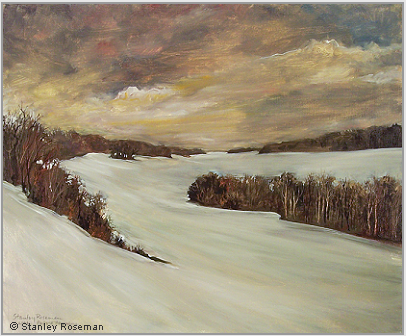
At his easel in the French countryside, Roseman painted the panoramic Winter Landscape in Lorraine, 2008, presented below, (fig. 4). Under a vast sky of gray-blue, pale-magenta, and light ochre, a grove of slender trees stands on a snowy plot in a plowed field. The artist has rendered in fine detail the grove with its filigree of bare branches set against the variegated hues of winter.
3. Stanley Roseman at his easel in a snowy field in the French countryside, 2007. The artist is seated under a wide umbrella, which protects the canvas from potential snow flurries on a cold, overcast day. Roseman's working method is to cover the back of the canvas with a sheet of protective cardboard. The artist is wearing a workman's apron and woolen gloves without finger tips, a winter clothing accessory called "mitaines" in French. Placed on the crossbars of his portable easel, his paint box serves as a worktable.
Roseman writes in his journal: "Spring, summer, and autumn can be very pleasant times of the year to be at my easel or with my drawing book on a grassy hillside or in some secluded valley. However, when the North Wind brings ever colder days, I endure the cold for the inspiration that also comes from painting and drawing en plein air in winter.''
Painting and Drawing en plein air in the Four Seasons
4. Winter Landscape in Lorraine, 2008
Oil on canvas, 35 x 76 cm
Private collection, Virginia
Oil on canvas, 35 x 76 cm
Private collection, Virginia
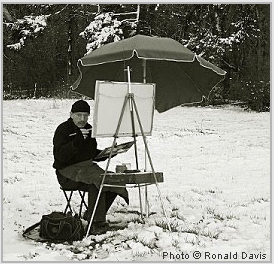
5. The Source, a Winter Landscape, 2008
Oil on canvas, 50 x 74 cm
Private collection, Pennsylvania
Oil on canvas, 50 x 74 cm
Private collection, Pennsylvania
The composition contrasts horizontal segments of the rural terrain. The plowed field in the foreground, rendered in burnt sienna and burnt umber, extends the width of the canvas. Receding into pictorial space in the left middle distance are dense woods of gray-greens and browns. The snowy pastureland is painted with sweeping brushstrokes of white pigment. Gray-green forests and more snowy fields in the far distance line the horizon. The superb painting conveys stillness on the land and movement in the iridescent, wintry sky.
Biography: Page 9
Landscapes continued
Landscapes continued
Page 9 - Landscapes
2. Fields and Woodlands in Winter, 2006
Oil on canvas, 50 x 60 cm
Private collection, France
Oil on canvas, 50 x 60 cm
Private collection, France
Roseman has created an impressive oeuvre of landscape paintings and drawings in France. The artist writes in his journal, "I love the city but I also love the countryside, and I am deeply grateful for the inspiration that both the city and the country provide me for my work.''
With paint box, canvases, portable easel, and drawing book and shoulder bag with chalks and pastels, Roseman began making sojourns from Paris in 1999 to the countryside in the northwestern and northeastern departments of France. Over the following years, with his move to the country, he dedicated a large part of his work to landscapes.
Spring
6. Fields of Colza in Lorraine, 2015
Oil on canvas, 33 x 55 cm
Private collection, Maine
Oil on canvas, 33 x 55 cm
Private collection, Maine
7. Birch Trees on a Summer Evening, 2016
Oil on canvas, 50 x 50 cm
Private collection, Switzerland
Oil on canvas, 50 x 50 cm
Private collection, Switzerland
9. Wooded Ravine in Picardy, 1999
Chalks and pastels on paper, 35 x 35 cm
Private collection, Switzerland
Chalks and pastels on paper, 35 x 35 cm
Private collection, Switzerland
Roseman paints with umber, sienna, and brown ochre to depict the groves and the woods on the wintry terrian. Detail rendering defines the dormant vegetation. Slender birch trees add vertical, white accents to the browns and maroon tones of the woodlands. The broad, sweeping S-curve of white pigment describes the vast snowy fields in this beautiful snowscape.
Snow-covered fields from the foreground to the distant horizon fill half the composition complemented by the golden light of an animated sky rendered with vigorous brushwork.
Lorraine in spring is abundant with fields of colza in full bloom. Standing at his easel on a hill overlooking the rural countryside, a view Roseman knew well from living in the region, the artist painted Fields of Colza in Lorraine, 2015, (fig. 6). This splendid landscape with its expanse of atmospheric perspective juxtaposes cultivated fields of colza and green vegetation. The abstraction of yellow and green geometric shapes is complemented by the natural forms of trees and hedges.
Woodlands in the far distance border the cultivated fields. The distant fields of colza add accents of yellow to the gray-greens of the hilly terrain on the horizon. Passages of light blues, pinks, and ochres illuminate the sky on a beautiful spring day in the Lorraine countryside.
Birch Trees on a Summer Evening, 2016, (fig. 7, below), composed on a square canvas, depicts a view in the department of the Meuse in the region of Lorraine. Birches recur often in Roseman's landscape paintings and drawings. The beautiful and hardy birch tree with its white bark appeals to the artist's aesthetics as does the birch's association with writing appeals to the artist's love of books. Roseman notes in his journal: "I have read that the thin yet durable bark of birch trees was much used in ancient times as a pliable and transportable surface for writing upon before the invention of paper.''[1]
Birches stand near the crest of a hill in this impressive, summer landscape. Fluent brushwork animates the early evening sky, which fills two-thirds of the canvas. In the north of France in summer, the daylight hours are long, an advantage for the artist painting en plein air in evening. Roseman has captured an ambience of early evening with passages of blue sky and the movement of darkening clouds in tones of anthracite, warm grays, and grayish-white descending to the horizon. The fading light has darkened the bucolic terrain and softened the contours of groves and woodlands in the distance.
Roseman's landscapes are a synthesis of the artist's direct observation of Nature
and personal expression in the creative process.
and personal expression in the creative process.
The steep angle of the hill is complemented by tall, slender birches with their white trunks and branches and the summer foliage painted in varying hues of green nuanced with blue. Light filters through thin and leafy branches silhouetted against the sky. Roseman has expressed a feeling of quietude on a summer evening in the beautiful Lorraine countryside.
8. Along a Riverbank on a Summer Afternoon, 2000
Chalks and pastels on paper, 20 x 30 cm
Collection Ronald Davis
Chalks and pastels on paper, 20 x 30 cm
Collection Ronald Davis
Drawings account for a great part of Roseman's oeuvre. Speaking about the importance of drawing, the artist acknowledges Giorgio Vasari: "The celebrated sixteenth-century Florentine architect, painter, and author of Lives of the Artists affirmed that drawing is the animating principle of the creative process.[2] Vasari, who was the first great collector of drawings, esteemed drawings for their inherent value."[3]
Although drawings have traditionally served as studies for compositions to be realized in another medium, drawings can be autonomous works of art, as are Roseman's drawings. A versatile and prolific draughtsman, Roseman employs a variety of drawing materials to express a diversity of subjects, including landscapes.
1. Alexander Porteous, The Forest in Folklore and Mythology, (Mineola; Dover Publications, Inc.,2002), pp. 248, 249.
2. Giorgio Vasari, Vasari on Technique, (New York: Dover Publications, Inc., 1960), p. 205.
3. Nicolas Turner, Florentine Drawings of the Sixteenth Century, (London: British Museum, 1986), p. 189.
4. Stanley Roseman - Dessins sur la Danse à l'Opéra de Paris, (Paris, Bibliothèque Nationale de France, 1996), pp. 12, 13.
2. Giorgio Vasari, Vasari on Technique, (New York: Dover Publications, Inc., 1960), p. 205.
3. Nicolas Turner, Florentine Drawings of the Sixteenth Century, (London: British Museum, 1986), p. 189.
4. Stanley Roseman - Dessins sur la Danse à l'Opéra de Paris, (Paris, Bibliothèque Nationale de France, 1996), pp. 12, 13.
Seated along a riverbank in the département of the Manche in northwestern France, Roseman drew the work Along a Riverbank on a Summer Afternoon, 2000, (fig. 8.) In the pyramidal composition drawn with chalks and pastels, a group of trees and shrubs are set against a background applied with white parallel hatching on gray paper, which gives the impression of a veiled summer sky. Passages of green-ochre, viridian, and greenish-black establish the forms of trees and shrubs in pictorial space.
A cool, afternoon light falls across the green meadow that extends to the banks of the river, where more shrubbery in the right foreground meets the river's edge. The slow moving current partially obscures the reflections on the water's surface in this beautiful landscape drawing.
"Stanley Roseman's drawings show the many facets of his great talents as a draughtsman."[4]
- Bibliothèque Nationale de France
Roseman and his colleague Ronald Davis travelled together over the years to bring to realization the artist's landscape oeuvre. They have made a number of excursions to Picardy, an historic region in northwestern France.
Roseman's landscapes, painted and drawn in the four seasons, include depictions of different terrain and weather conditions, as with the drawing Pines on a Foggy Afternoon in the Vosges Mountains, 2000, (fig. 11). The evocation of that special atmospheric condition in Roseman's work brings to mind Whistler's representation of a view across the Thames on a foggy winter morning or Winslow Homer's painting of his studio in an afternoon fog on the coast of Maine.
Far from city or seacoast, Roseman took up paper, chalks, and pastels to draw on a foggy autumn afternoon in the Vosges Mountains. The forested massif with its high summits extends west of the Rhine River Valley in the Alsace and the département of the Vosges in Lorraine.
The composition of the drawing integrates a triangular leitmotif in the shapes of the stately pines and their branches becoming enveloped in fog. The blending of the chalks and pastels almost completely covers the paper surface in the artist's rendering of forms and aerial perspective.
11. Pines on a Foggy Afternoon in the Vosges Mountains, 2000
Chalks and pastels on paper, 38 x 28 cm
Private collection, France
Chalks and pastels on paper, 38 x 28 cm
Private collection, France
Roseman has reserved a circular area of the white paper for the sun shining through the fog, and in so doing, he has added a luminous accent to this beautiful landscape drawing.
Summer
Autumn
With the car parked on the roadside, Roseman took out of the trunk his drawing book, shoulder bag of chalks and pastels, and folding stool and found a perspective that inspired him to draw Wooded Ravine in Picardy, 1999, (fig. 9).
Searching for a remote site indicated on their road map, Roseman and Davis came upon a narrow road which they took to descend into a deep, wooded ravine, the destination of their search on that warm, sunny afternoon in mid-July 1999. Continuing on for a distance, they came to the end of the road, where the ravine rose steeply before them.
This impressive drawing is composed with a strong diagonal of earth and sky. Roseman draws the summer landscape predominantly in dark greens and gray-blues with additions of black chalk in expressing the ambience of the deep ravine.
The dark foliage in the immediate foreground on the left and right of the drawing directs the viewer's gaze into pictorial space. Three tall, slender trees stand parallel in the mid-distance. Sunlight falling on the steep slope of the ravine adds a bright passage before the trees and shrubbery silhouetted against a luminously white sky.

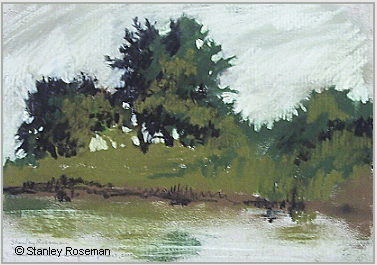
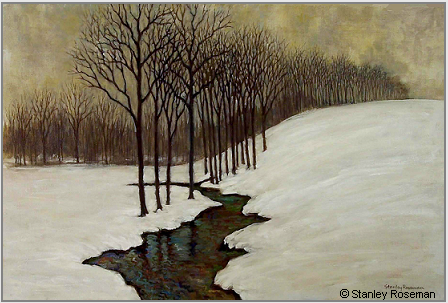
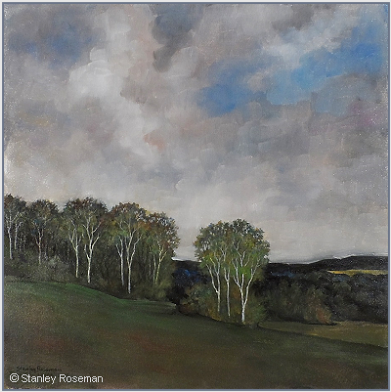
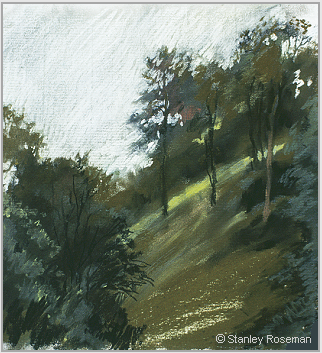
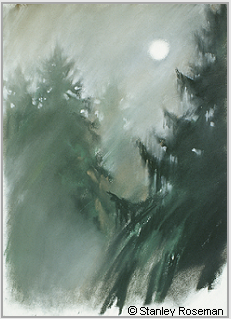
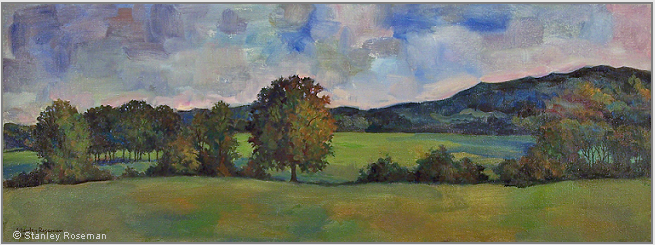
The splendid landscape painting A Summer Afternoon in Lorraine, 2009, is presented below, (fig. 10). Roseman recounts: "Driving into the countryside with my art supplies, I turned onto a rural road that leads to a view where trees and shrubs demarcate green pastures and the great woodland rises in the distance. The summer sky was to me like a kaleidoscope of colors, from light tones of blue, violet, and crimson to magenta and ultramarine deep. I appreciate the quietude and the long, summer afternoons at my easel in the open air."
10. A Summer Afternoon in Lorraine, 2009
Oil on canvas, 30 x 80 cm
Private collection, Illinois
Oil on canvas, 30 x 80 cm
Private collection, Illinois
Roseman's landscapes are distinctive in their division of pictorial space. In the present work, the pasture in the foreground is nuanced in green hues with subtle transitions to gold-ochre and soft shades of blue that are repeated in the finely rendered trees, hedges, and grove beyond, lit by the afternoon sun. To the right side of the stately oak is a passage way that invites the viewer to proceed farther into the spacial dimension of the picture, where long, blue shadows pattern the bright green pasture.
The distant woodland, rendered in deep blues with accents of greens, gold, and magenta, fills the horizon and brings a dramatic diagonal element to the composition. The crest of the high hill is in sharp relief against the beautiful, afternoon sky, whose chromatic variations applied with bold brushstrokes complement the colors of the terrain. With painterly textures and vibrant palette, Roseman's landscape is a celebration of summer in all of its glory.
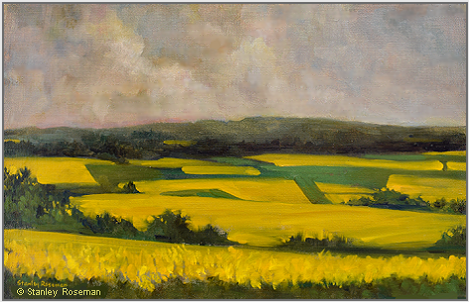
Roseman's affinity for city life, with his passionate interest in the performing arts, is exemplified by his years drawing the dance at the Paris Opéra. The artist's deep feeling for Nature is eloquently expressed in his landscape paintings and drawings.
The groves on the crest of the hill are finely rendered and recede into pictorial space. Roseman has created an affective composition whereby the viewer is looking up the hillside at the light snowfall. The grove in the far distance is veiled with an approaching mist. Tones of silver-gray, light blue, and pale ochre depicts a wintry sky over the rural countryside of the Ardennes.
Winter
LANDSCAPES: Landscapes of Switzerland
Landscapes of France
Roseman painted The Source, a Winter Landscape, 2008, (fig. 5, below), in the farming countryside of Lorraine. On a rising, snow-covered pasture, the source flows out from the hillside. Continuing along the bottom of the hill, the source becomes a brook that divides the lower half of the picture plane. Tall trees, their bare branches forming fan-like patterns, stand parallel to one another on both sides of the source and bring vertical elements to the painting.
The artist has placed the source near the center of the composition in the middle distance. The snowy embankments define the edges of the brook as it widens in the foreground and flows towards the viewer. The slender tree trunks are reflected in the rippling water rendered in dark brown, cerulean blue, viridian, ochre, and magenta.
Roseman combines warm and cool tints of white in brushing in the snowy ground. The leitmotif of tall trees is repeated in the row of trees that extend across the canvas and over the hill. Woods recede farther into the distance. The luminous sky is painted in complementary passages of blue-gray and light ochre in this superb winter landscape.
Pasture and Woodland in Autumn, 2004, (fig. 12, below), is a splendid painting of which the artist renders the landscape with a freedom of brushwork and a harmonious juxtaposition of warm colors of the fall foliage, accented with passages of cerulean blue and complemented by vivid greens of the grassy hillside.

12. Pasture and Woodland in Autumn, 2004
Oil on canvas, 46 x 40 cm
Oil on canvas, 46 x 40 cm
Private collection, Belgium
The composition is based on a geometric division of the canvas in three distinct areas of earth, woods, and sky. With painterly textures, strong lights and darks, and fluent strokes of autumnal colors, Roseman renders the triangular expanse of woodland in contrast to the sweeping diagonal of the verdant pasture and the rectangular pictorial space of the pearl-gray sky.
The deep perspective of the woodland is painted in tones of maroon and burnt sienna, with accents of white of the distant birches. Six birches stand in the near middle distance and bring vertical elements to the composition. The birches with their white trunks and golden foliage enhance the beauty of this autumn landscape.
